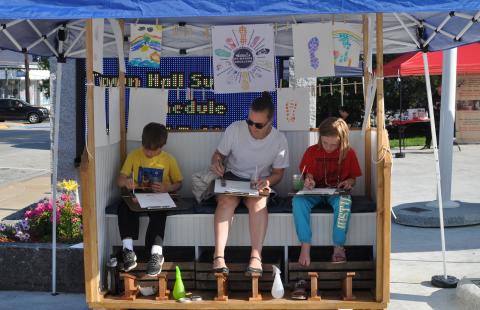What were the specific goals of this creative economy project? Describe the community development challenge or opportunity that your project was designed to address:
Based on conversations with the Town of Rockland and input from the Advisory Committee, the MAPC team established five goals for the Creative Placemaking Demonstration Project Concept and Strategy:
- Identify areas of strength and areas of opportunity for creative placemaking within downtown Rockland.
- Implement a fully developed creative placemaking project, working collaboratively with local artists, Union St. businesses, and town staff.
- Enhance the transformation of Rockland by integrating arts and culture into Downtown Rockland’s revitalization.
- Engage artists, residents, and business owners in a collaborative process that leads to artistic products with broad community-support and wide-spread appeal to support reaching fundraising goals.
- Change the public perception of downtown Rockland by increasing visibility of art along the Union Street corridor.
Who was involved in this project and what did they do? (be sure to include the partners from outside of the creative sector and how local voices were included):
Key players:
- Marcy Birmingham - Project Coordinator, Town of Rockland
- Mike Mullen - Selectman, Town of Rockland
- Dave Taylor - Highway Superintendent
- Pat Foley - Library Trustee and Downtown Resident - support with community connections
- Christine Flaherty - REiMAGINE ROCKLAND - outreach
- Megan Murphy - REiMAGINE ROCKLAND - outreach
- Cheryl Thompson - Rockland High School Art Teacher - connected us to work with students to paint stencils on the sidewalks
- Andy Healey - Rice Building Owner - we hung art in the vacant storefront windows
Meeting hosts:
- Peggy Bryan - Senior Center Director
- Alan Curtis - Owner Sandpaper Factory - artist and creative entrepreneur spaces
Advisory support:
- Vinnie Fountaine - Rockland Veterans Agent
- Jeanne Blaney - Rockland Youth Commission Director, administrative support
- Janet Cann - Library Trustee and Downtown Resident
- Robin Cook Hill - Rockland Day Committee Vice Chair, Farmers Market Manager and Downtown Resident
- Erik Dykemann - South Shore Chamber of Commerce Community Relations
- Linda Downer - Christian Science Reading Room
- Jim Paul - Rockland Historical Commission
- Megan Fountaine - Rockland Resident
- Neia Callahan - Rockland Public School's Portuguese translator
- Beverly Brown - Rockland Public Library - had an event on the front lawn of the library
- John Cheney - Friends of the Library, Rockland Cultural Council
Artists who supported the project:
- Shi Shi McGann - President 4th floor artists
- Mary Wyman - local artist
- Donna Roine - 4th floor artist and Rockland Resident
- Heather Dunham - Special Ed Teacher, Rockland Resident, artist
- Jan Yeh - Cohasset Resident, had “Presidential” studio space
- Joan Dalto - teaches drawing lessons to youth in her studio, on the Rockland Cultural Council
Businesses who supported the project:
- Megan Dunphy - MountainOne Bank Manager and Rockland Resident
- Paul Sneyd - downtown business owner
- Barbara Wahlstrom - South Shore Hospital Foundation Staff member and Rockland Resident
- Heather Weydt - Rockland Trust Vice President and Rockland Branch Manager
How does this project relate to a larger community development strategy?
The town received a Massachusetts Downtown Initiative grant last spring, which is helping to fund REiMAGINE ROCKLAND’s efforts. The Massachusetts Downtown Initiative is a division of the Department of Housing and Community Development that offers assistance to cities and towns looking revitalize their communities’ downtowns. It addresses the economic and community development needs of the towns it works with while also providing a framework that promote positive change to keep the downtowns healthy and successful.
The mission of REiMAGINE ROCKLAND is to create a bustling, inclusive and prosperous downtown, on and around the Union Street corridor. Other programs initiated by REiMAGINE ROCKLAND’ also include the clean-up and beautification of Union Street, the development of a diverse commercial area and various community activities on Union Street.
